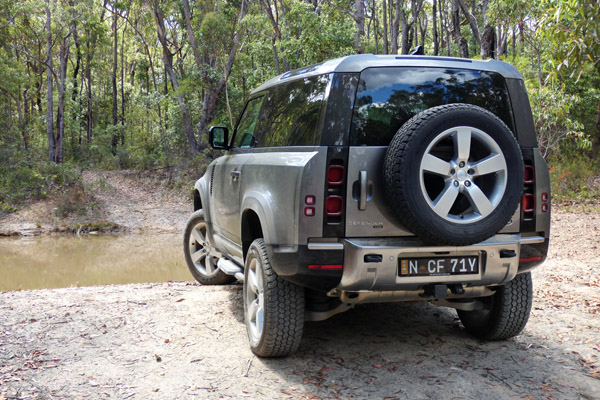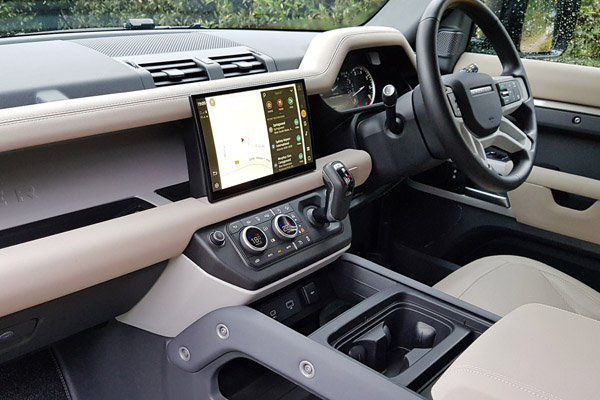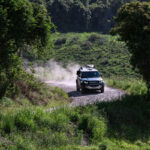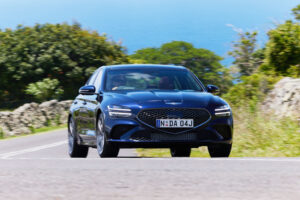
Let’s get something straight. Land Rover’s Defender maybe an icon, but as for legendary —
well, they weren’t very reliable.
In this country, if you wanted to head off the beaten track, you got a Land Cruiser,
preferably the workhorse version with its skinny tyres, part-time 4×4 and mechanical diff
locks – with a bullbar and snorkel for good measure.
It’s the car you invariably find parked in sheds on farms across the land. Land Rover calls
this new car a Defender, but it doesn’t look or feel much like the last one we drove.
In reality, it’s a Defender in name only. For starters, you no longer need to stick your elbow
out the window, just so you’ve got room to turn the bloody wheel.
Nope. Time has moved on and so has the Defender, thank goodness, which is now much
more accommodating and finally safe – as safe as airbags and electronic assistance can
make it.
The question is . . . can it do the things its predecessor could? And who pray tell is this
sensitive, new age off-roader aimed at?
STYLING
Defender’s unique retro design is the work of Gerry McGovern, who we’ve met. It’s
something else, with nods to the original, but unlike anything else on or off the road, and
definitely pitched upmarket.

McGovern says new Defender is respectful of its past but is not harnessed by it.
A stripped down, more utilitarian version called Hard Top is offered for Govt/commercial
duties.
Back in 2015 when the old Defender was in run out, the car was suddenly in hot demand.
But you could pick up the runt of the litter, a Defender 90, for as little as $42 grand plus on-
roads.
Fast forward and prices for the all-new Defender start from $81,950 for the tw0-door,
turbocharged 2.0-litre Defender 90 P300. I’m no maths whizz, but that’s almost twice the
price of the vehicle it replaces.
Four option packs are available that bundle accessories.
Our test vehicle, the SE P400, is $105,690 or in this case $124,254 with a few extras
thrown in – plus on-roads.
In standard form it comes with all-wheel drive, low range gearing, coil suspension, off-road
terrain modes and 18-inch steel wheels with all-terrain rubber.
A spare wheel cover is a $758 option, air suspension is $1309 and a snorkel now known
as a “raised air intake” is $1673.
Cloth trim and two-zone climate air are also standard, along with a 12.3-inch digital
instrument panel, eight-way part-powered seats, LED head and tail lights, heated, electric,
power-fold door mirrors with approach lights and auto-dimming driver side, auto-dimming
rear view mirror and 40:20:40 fixed rear seats with centre armrest.

Our SE P400 test vehicle steps up to 20-inch alloys, keyless entry and body-coloured door
handles, grain leather trim, Dinamica wrapped steering wheel, 12-way power-adjust front
seats with 2-way manual headrests, premium cabin lighting, front fog lights and premium
auto-levelling LED lights with signature DRL and auto high beam and cornering lights.
INFOTAINMENT
Infotainment consists of an 11.4 curved touchscreen, with Pivi Pro (Connected) which
includes a remote, built-in navigation, AM/FM/DAB digital radio, wireless phone charging
and wired Apple CarPlay and Android Auto, with 400-watt Meridian audio with 11 speakers
including a subwoofer.
ENGINES / TRANSMISSIONS
The powerful six-cylinder P400, with the support of a mild hybrid setup produces an
impressive 294kW of power at 5500 rpm and 550Nm of torque from 2000-5000 rpm. Drive
is to all four wheels through an eight-speed automatic transmission, with auto stop-start
and a torque on demand ‘two-speed’ all-wheel drive system.
SAFETY
With a five-star safety rating, it comes with six airbags, 3D surround camera, 360-degree
parking aid, driver condition monitor, cruise control and speed limiter, lane keep assist,
emergency braking, rear cross-traffic alert, traffic sign recognition with adaptive speed
limiter — while the SE adds blind spot assist.
DRIVING
Designed primarily to go off road, the previous diesel-powered Defender was a slug and
was not happy doing more than 100km/h on the bitumen. Not so this one. It can sprint
from 0-100km/h in an amazing 6.0 seconds and on to a top speed of 191km/h in standard
form or 208km/h with 22-inch wheels.
It drinks premium 95 unleaded and fuel consumption is a claimed 9.9L/100km.
Unlike its predecessor, instead of body on frame, the new Defender features a unibody
construction that integrates body and chassis. No parts carry over from its predecessor
although it does share components with other models in the Land Rover and Range Rover
lineups, including engines, gearboxes and differentials.
Land Rover says the aluminium-intensive D7x body architecture is three times stiffer than
the best body-on-frame designs.
But the chain-driven transfer case, axles and propshafts and suspension elements have all
been beefed up to cope with the rigours of off-road driving.
The ZF transmission is also stronger and cooling components have been moved to keep
them out of the way and provide more clearance.
The biggest and most apparent transformation is the way the car steers and handles on
the road, where the new Defender is now up to being a daily driver.
Defender 90 (the number traditionally refers to the length of the wheelbase in inches) is
4583mm long with a 2587mm wheelbase (which has grown from 90 to 102 inches). This
includes the spare wheel which sits on the tailgate and that incidentally opens in an Oz-
friendly left to right direction, but beware because it’s heavy.
The 90 is 2005mm wide with mirrors and stands 1974/1969 mm tall, depending on
whether it is fitted with coil or air suspension (ours had air).
Weighing in at 2245kg it sits on wheels that range from 18 to 22 inches in size and are
fitted with tyres in profile from 255/70 to a low profile 275/45 series with an aggressive
tread pattern.
A walkaround of Defender 90 reveals many body parts are made of plastic. That includes
the entire front grille, checker plate bonnet top inserts, front quarter panel vents and the
dark grey wheel arch flares.
A closer inspection reveals some of the shut lines do not quite line up and we noticed the
flares do not sit flush in sections. Like aluminium, plastic saves weight but any or all of the
parts could easily be damaged off road.
Inside, the cabin has the look and feel of a 20-year-old Discovery with its choice of colours
and finishes.
A dash-mounted transmission lever allows a centre ‘jump’ seat to be substituted for the
console which means it can seat up to six people at a push.
Our test vehicle came with the large 14.1-inch touchscreen, but retained the less
sophisticated “no cost option” instrument cluster, with analogue dials and inset info screen.
Say what? Who the hell is going to option this? The Jaguar F-Pace we drove was the
same, suggesting component supply problems.
The ClearSight electronic rear view mirror had been added, which uses a camera to
bypass the headrests and spare wheel that fill the rear window.
Good idea but we found it highly reflective, difficult to focus on and it made us feel
nauseous. My wife too.
ClearSight Ground View technology provides a view of the area in front of the car that is
normally obscured by the bonnet, and that can be handy off road. Fresh from bagging a
top-of-the-line Jeep, however, we were hesitant to take the Defender off road.
A $1500 insurance excess is no incentive either. It’s so easy to scratch paintwork and dent
running boards in the kind of conditions encountered on fire trails, unlike the forgiving mud
larks that Land Rovers are often photographed performing back home.
With standard coil suspension ground clearance is 226mm and it has a wading depth of
850mm. With air suspension fitted, it receives a 75mm lift, with clearance ranging from 216
to 291mm, and wading 900mm.
In comparison, the two-door Jeep Wrangler Rubicon offers 225mm of ground clearance
and a wading ability of 760mm.
Interestingly, you can opt for $6500 factory fit satin wrap to protect paintwork, available
with one of three body colours — Indus Silver, Gondwana Stone or Pangea Green.
Permanent all-wheel drive, low range gearing, a centre differential and optional active
locking rear differential provide the basis for exceptional off-road capability.
In conjunction with air suspension, Terrain Response 2 includes a new Wade program for
calculating the depth of water. No need to pack the Wellies.
Push the off-road button, watch the bonnet rise in front of you and you’re ready to hit the
dirt. You can play with the controls via the touchscreen or simply let the Defender do its
stuff, with Mud-Ruts, Grass-Gravel-Snow, Comfort, Sand, Eco, Rock Crawl modes.
While the interior is reminiscent of the Disco, off road the Defender feels a lot like Range
Rovers of yesteryear with their air suspension and pioneering terrain response settings. So
does the fuel consumption quietly. The big six was getting 12.1L/100km after close to
500km and this is where a diesel is desirable.
There is some hesitation from the accelerator most of the time, making low-speed
manoeuvres tricky and the brakes are grabby, pulling the wagon to an abrupt stop that
sends occupants forward then back again.
Off the line, Defender will show a clean pair of heels to the drivers of most utes.
The more you drive the car, the more it inspires confidence.
We weren’t quite brave enough to take on the bog hole of doom, but we did get the
Defender pretty dirty.
However, with recovery points fitted at the rear, it’s a warning to heed the 4×4 creed.
It goes something like this: Don’t go anywhere unless you have to and, if you do, then get
out and take a look first. Make sure you’ve got a plan B in case things go wrong
SUMMING UP
It’s nothing like the old Defender and that’s a good thing. First and foremost, it’s a much
better device to drive, fun even on bitumen with its potent six-cylinder petrol engine.
With air suspension fitted and the six inches of extra ground clearance that brings, the
Defender 90 has the makings of an off-road champion.
We’d dearly love to take on the bog hole that got the better of our Jeep Gladiator and see
if it makes it out the other end, but once bitten twice shy.
In the meantime, Defender’s cool looks and mix of on and off-road prowess will appeal to a
much broader range of buyers and we’re guessing that’s Land Rover’s main objective.
RATINGS:
Looks: 8.5
Performance: 8
Safety: 8
Thirst: 6
Practicality: 7
Comfort: 7.5
Tech: 8
Value: 7
Overall: 7.5
AT A GLANCE
MODEL RANGE
Defender 90 S P300: $90,150
Defender 90 D 250: $97,450
Defender 90 SE P400: $107,850
Defender 90 X P400: $149,200
Defender 90 V8 P525: $221,300
Note: These prices do not include government or dealer delivery charges. Contact your
local Land Rover dealer for drive-away prices.
SPECIFICATIONS (Land Rover Defender 90 SE P400, 3-door wagon, 3.0-litre twin turbo
in-line six, with 48-volt mild hybrid, 8-spd auto, AWD)
PERFORMANCE:
Capacity: 3.0 litres
Configuration: 6-cyl, in-line, twin-turbo, mild hybrid
Maximum Power: 294kW @ 5550 rpm
Maximum Torque: 550Nm @ 2000-5000 rpm
Fuel Type: 95 premium unleaded petrol
Combined: 9.9 L/100km
CO2 Emissions: 230 g/km
DRIVELINE:
8-speed automatic, high/low range all-wheel drive
DIMENSIONS, WEIGHT AND CAPACITIES:
Length: 4583 mm (with spare wheel)
Wheelbase: 2587 mm
Width: 2105 mm (with mirrors)
Height: 1974 mm (coil suspension) | 1969 mm (air suspension)
Turning Circle: 11.3 metres
Kerb Mass: 2245 mm
Fuel Tank Capacity: 90 litres
BRAKES:
Front: Ventilated disc
Rear: Ventilated disc
STANDARD WARRANTY:
Five years/unlimited kilometres








